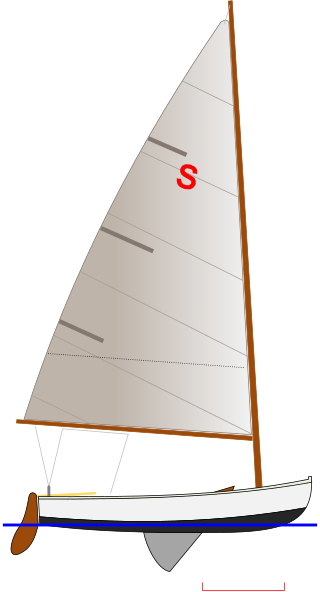The El Toro is an American pram sailboat that was designed by Charles McGregor as a sail training dinghy and yacht tender, first built in 1939. It is now often sailed as a singlehanded one-design racer.

The Firefly is a British sailboat that was designed by Uffa Fox as a one design racer and first built in 1946. The boat was originally named the Sea Swallow. It was an Olympic class and raced at the 1948 Olympics.

The Laser 2, or Laser II, is a sailboat that was designed by New Zealander Frank Bethwaite and Canadian Ian Bruce as a one-design racer and first built in 1978.

The Snipe is an American sailing dinghy that was designed by William F. Crosby as a one design racer and first built in 1931.

The International FJ is a Dutch sailboat that was designed by Uus Van Essen and Conrad Gülcher as a trainer and one design racer, first built in 1956.

The International 14 is a British racing sailboat, crewed by two sailors. The class was established in 1928.

The Vanguard 15 is an American planing sailing dinghy that was designed by Bob Ames as a one-design racer and first built in 1992.

The Penguin is an American sailing dinghy that was designed by Philip Rhodes in 1933 as a one design racer for frostbite racing on the US east coast and first built in 1939.

The Snowbird is an American sailboat that was initially designed by Willis Reid as a one design racer and first built in 1921. The boat was re-designed by Edson B. Schock in the 1940s and it became a popular junior class.
The W. D. Schock Corporation is an American boat builder originally based in Newport Beach, California, later in Corona, California and currently located in Santa Ana, California. The company was founded by William "Bill" D. Schock in 1958 and specializes in the design and manufacture of fiberglass sailboats.
The Cape Cod Frosty is an American sailing dinghy that was designed by Harwich, Massachusetts harbormaster Thomas Leach as a one-design racer and first built in 1984.
The Capri Cyclone, also referred to as the Cyclone 13 or just the Cyclone, is an American sailing dinghy that was designed by Frank V. Butler as a one-design racer and first built in 1970.
The Catalina Catamaran is an American catamaran sailboat that was designed by W. D. Schock Corp's in-house designer, Seymour Paul, as a racer and day sailer, It was first built in 1960.
The Lehman 12 is an American sailboat that was designed by Barney Lehman as a one design racing sailing dinghy and first built in 1953.
The Lehman Interclub, also called the Lehman 10, is an American sailboat that was designed by Barney Lehman as a one design racer and first built in 1958.
The Metcalf is an American sailboat that was designed by Bill Lapworth as a racer and first built in 1960. The boat is named for Darby Metcalf who built the first example.

The Polynesian Concept is an American production catamaran sailboat that was designed by Rudy Choy of C/S/K Catamarans, in conjunction with actor Buddy Ebsen. Intended for cruising, it was first built in 1970. Ebsen had built the wooden prototype, named Polynesian Concept and raced it in the 1968 Transpacific Yacht Race.
The Twitchell 12 is an American sailboat that was designed by Ron Holder as a day sailer for people with limited mobility and first built in 1991.

The Waszp is an Australian, single-handed, hydrofoiling sailboat that was designed by Andrew McDougall as a one-design racer for youth and adults, and first built in 2016.
The Melges 14 is an American planing sailboat that was designed by Reichel/Pugh as a one-design racer and first built in 2016.










